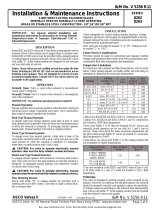
Page 2 of 7 (Section 1 of 2)
ASCO Valve, Inc.
50 Hanover Road, Florham Park, New Jersey 07932 www.ascovalve.com
I&M No. V 7466 R3
Testing for External Leakage
WARNING: To prevent the possibility of
death, serious injury or property damage,
extinguish all open flames and avoid any type
of sparking or ignition.
1. Apply pressure to valve within nameplate rating with solenoid
energized.
2. Apply a soapy solution or a commercially available leak
detecting solution to thepipeconnectionsand check for bubbles.
If the valve has been disassembled and reassembled for
inspecting, cleaning, or rebuilding apply the solution around
solenoid base sub--- assembly and bonnet/body joint.
3. If leakage exists, depressurize valve and turn off electrical power
supply. Tighten connections as required and retest following the
above steps.
Wiring (Electrical Position Indicator)
Wiring must comply with local codes and the National Electrical
Code. Switch housing has a 1/2 conduit connection. The position
indicator switch has been preset at the factory. This switch is not to be
field adjusted. Position indicator housing assembly can be rotated
360 for desirable visual position. Position indicator is furnished
standard with one reed switch having a single contact to open when
the valve is in the openposition. The switchrating is 1 ampmaximum,
120/60 AC maximum and 15 volts---amps maximum (Resistive Load)
or 1 amp maximum, 120 volts DC maximum and 15 watts maximum
(Resistive Load). For lamp and inductive loads, contact protection
is required.
MAINTENANCE
WARNING: To prevent the possibility of
death, serious injury or property damage,
turn off electrical power, depressurize valve,
extinguish all open flames and avoid any type
of sparking or ignition. Vent hazardous or
combustible fluid to a safe area before
servicing the valve.
NOTE: It is not necessary to remove the valve from the pipeline for
repairs. See Service Note under Valve Disassembly and Reassembly.
Cleaning
All solenoid valves should be cleaned periodically. The time between
cleanings will vary depending on the medium and service conditions.
In general,if the voltage to the coil is correct, sluggish valve operation,
excessive noise, or leakage will indicate that cleaning is required. In
the extreme case, faulty valve operation will occur and the valve may
fail to open or close. Clean strainer or filter when cleaning the valve.
Preventive Maintenance
Keep medium flowing through the valve as free from dirt and
foreign material as possible.
While in service, the valve should be operated at least once a
month to ensure proper opening and closing.
Depending on the medium and service conditions, periodic
inspection of internal valve parts for damage or excessive wear is
recommended. Thoroughly clean all parts. If parts are worn or
damaged, install a complete ASCO Rebuild Kit. Rebuild Kits are
not available for valves with Electrical Position Indicator Switch
(Suffix C).
Causes of Improper Operation
Incorrect Pressure: Check valve pressure. Pressure to valve must
be within range specified on nameplate.
Excessive Leakage: Disassemble valve and clean all parts. If parts
worn or damaged install a complete ASCO Rebuilt Kit or replace
valve.
Valve Disassembly
--- Service Note---
It is not necessary to remove the valve from the pipeline for
inspecting, cleaning, or rebuilding. However, for ease of valve
reassembly (after maintenance), the solenoid valve should be
temporarily in the upside---down position with the solenoid portion
completely assembled. Electrical hookup to the solenoid is also
required. This upside---down position allows easy alignment of parts
through bottom cavity of the valve and a free hand to help in parts
alignment. Therefore, it is recommended that whenever possible the
valve be removed from the pipeline for reassembly. This is the
preferred method and position for valve reassembly.
1. Disassemble valve in an orderly fashion usingexploded view for
identification and placement of parts.
2. Remove solenoid enclosure, see separate installation and
maintenance instructions.
3. Remove bonnet screws, valve bonnet, diaphragm spring,
diaphragm/core assembly and body gasket from valve body.
4. Unscrew solenoid base sub--- assembly from opposite side of
valve body. Thenremove solenoid base gasket from valve body.
5. All parts are now accessible to clean or replace. If parts are
worn or damaged, install a complete ASCO Rebuild Kit or
replace valve.
Valve Reassembly
1. Lubricate bonnet gasket and body gasket with DOW
CORNING 200 Fluid lubricant or an equivalent high---grade
silicone fluid.
2. Apply a light coat of TFL 50 Dry Lube to:
Valve seat
Valve body flange where diaphragm assembly seats against
valve body and body gasket.
Internal surface of valve bonnetwhere diaphragm assembly
seats when valve is in the de---energized (open position).
Seating surface of disc on diaphragm assembly.
IMPORTANT: If valve has been disassembled for
inspection and cleaning only and a Rebuild Kit is not
being installed, lubricate the diaphragm assembly (on
both sides) with TFL 50 Dry Lube.
3. Position solenoid base gasket in valve body.
4. Thread solenoid base sub---assembly into valve body.
5. Torque solenoid base sub--- assembly to 175 ± 25 in---lbs [19,8
± 2,8 Nm].
6. Reassemble solenoid, see separate installation and
maintenance instruction.
NOTE: If possible position valve in upside--- down position.












